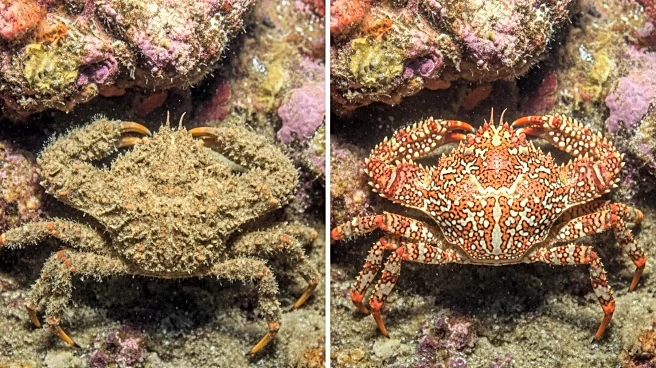What's Happening?
Professor Matthew Wills from the University of Bath has provided insights into the evolutionary phenomenon known as carcinisation, which refers to the process of becoming more crab-like. This process has occurred independently at least five times across
various crustacean lineages, resulting in 'imposter crabs' that have evolved similar physical traits despite not sharing a common ancestor. These adaptations, such as a rounded shell and sideways movement, offer improved protection and mobility, allowing these creatures to survive better in their environments. The phenomenon has sparked viral memes suggesting humans might eventually evolve into crabs, although Dr. Wills clarifies that this is not the case.
Why It's Important?
The study of carcinisation highlights the concept of convergent evolution, where unrelated species develop similar traits due to facing comparable environmental challenges. Understanding these evolutionary processes can provide insights into how species adapt and survive, which is crucial for fields such as evolutionary biology and ecology. The phenomenon also underscores the importance of adaptability in nature, offering lessons that could be applied to conservation efforts and the study of biodiversity. While the humorous notion of humans evolving into crabs has captured public imagination, the scientific explanation provides a deeper understanding of evolutionary mechanisms.
What's Next?
Further research into carcinisation and similar evolutionary processes could lead to new discoveries about how species adapt to their environments. Scientists may continue to explore the genetic and environmental factors that drive convergent evolution, potentially uncovering new strategies for species conservation. Additionally, public interest in these topics, fueled by viral memes, may encourage more engagement with scientific research and education, fostering a greater appreciation for the complexities of evolution.
Beyond the Headlines
The viral interest in carcinisation reflects broader cultural and scientific curiosity about evolution and adaptation. It highlights how scientific phenomena can capture public imagination and lead to increased interest in scientific literacy. The humorous aspect of the memes also demonstrates how science can be communicated in engaging ways, potentially inspiring future generations to explore scientific fields.














